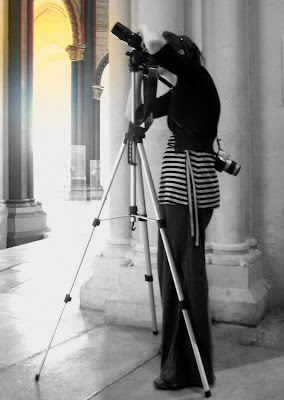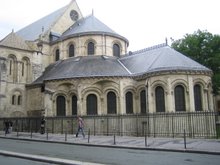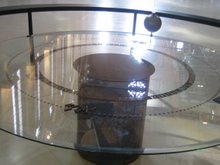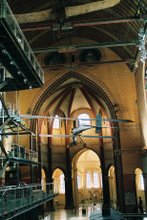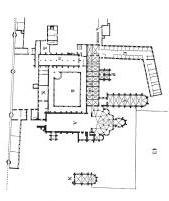Tuesday, 8 July 2008
finally
finished it.
printed it out.
handed it in.
yay.
well, the finishing part was a bit weird as i spent the last week of it cruising though Poland.
printing it yout was a nightmare as the copyshop computers wouldnt read my illustrations. So I had to print them out on my home computer. 7 hours straight - 150 pages. phew.
handing in went smoother thanks to everyone being really nice.
a few hours later I got shot by one of the professors who agreed to read and mark my work - only through the telephone, but still - because of how much Ive written.. hmm.
what I didnt mentiopn was the amazing second trip to Paris.. Staying in our own apartment, searching through libraries for archive material on the restaurations of Saint-Martin, taking more DIGITAL pictures of the choir itself, managing to get into Saint-Pierre-de-Montmartre, AND SAINT-QUIRIACE in Provins on the way there as well as SAINT-GERMER-DE-FLY on the way back, which I both heartily recommend... maybe Ill have time to post some pictures ,although I only have picture sof the architecture of the churches, whereas what makes these two little villages so lovely is their lonely atmosphere from many ages ago....
Tuesday, 15 April 2008
is life without spacebars possible?

its been a pretty busy month I have to say. after theeaster break was over, I started working quite a lot on my texts. especially those parts that actually are connected to art history. but now Im back to editing and correcting mostly historical bits an bops. Sometimes I feel like a private detective investigating in the case of Saint Martin. When I actually ought to be doing much more creative things like comparing one capital with another one or one bit of stone with another.. hmmm.
also, Ive found quite a lot of old plans and depictions of Saint-Martin that Ive been trying to analyse in the past week. Its quite interesting how unprecise even the ground plans from the 19th century are. Especially Viollet-le-Duc is making a complete fool of himself. it is pretty amazing, at least I think so, that Ive got two depictions of the church of Saint Martin from shortly after the Roman building was constructed (Chronique versifiée dated roun 1070s -1090s) and a nother two from the 13th century copy of that chronicle. My favourite one is by Fouquet though, although the reproductions Ive got of that illumination are pretty horribly blurred. Even Merian etched it, I think the younger one. When Ive handed this in I might load up lots of pictures, unless I get washed away of further obligations that Ive puttign aside allthat time now.
another thing are financial factors. Ill have to spent some 40 euro on printing and binding three sets of about 150 pages each, including illustrations. AND if I want colour pictures as well that would make some 33 euro more if I include 17 colour prints in each of those sets. or 23 euro for 10 colour prints in each.
I even have a file called my Masterproject and its the actual text Im gonna hand in... at some point. Though im altering it all the time. Its not finished yet. The main bits and the intro and conclu are pretty rough still or even non-existent. no conclusions yet. hehe. l'art pour l'art.
ok, thats all for now, folks. unless one of you can tell me how to put my spacebar back into place properly. i foolishly removed it earlier to get rid of all the fluffy dust underneath it, but it doesnt fit back on now. help.
Monday, 17 March 2008
Monday, 18 February 2008
its been a looong time, noooow Im coming back home...
Saturday, 12 January 2008
happy new year
Today Ive spent a remarkable amount of time cruising through the "Fotoindex Marburg" to get some more illustrations on other churches. They actually are quite a lot of pictures of Saint Martin as well. Mostly from the 1940s, which is not ideal for my purposes, but still historically interesting. The church seems to have been in quite an acceptable state back then. I remember seeing other "old" pictures of it with nailed up shattered windows, the walls falling apart and the ground around it receeding. That might have been just before the restaurations of the 1910s then, maybe. Although I had kind of remembered that picture being from the 20s or 30s. Hmm. Ill find out at some point. Im still at odds with a couple of things, but it helps to see all those other, more or less contemporary churches; for one starts to realize the actual character of Saint Martin as opposed to all the other pompous cathedrals, provincial churches and the slightly more sophisticated as probably later attempts.
Im looking forward to the next part now, the summary of all the books and essays written on Saint Martin. Its gonna be hard work, but at least I will get back into the texts, some of which I read only briefly ages ago, so that I will hopefully get a better overview about the more general opinions as well as the rather detailed analyses.
It kind of feels like I still havent started writing yet, but looking at the above and below it just needs a bit of editing and I have nearly 20 written pages already! In the meantime Ive also decided to use digital illustrations and to print them out in colour. Its more fuss on the one hand, but also less on the other - but its definitely going to be neater. hehe. word of the blog. Oh, AND there will have to be a picture on the front page. Probably simplement le chevet...
Tuesday, 4 December 2007
a neat description is something else
The advantages of that detailed decription are manifold: firstly, I had to look at the whole thing for a long time, in order to recognize patterns or systems, had to check every detail in every bay, on every pillar, to make sure if it was the same, to find out which columns is carrying which rib and so on. In a way, its the first time Ive conciously looked at the building really thoroughly. Secondly, based on this detailed inspection I can now start to analyze the differences and regularities, maybe distinguish some links within the building in order to get a sequence of building, or also links to other buildings that have similar forms at a similar point of time in the 12th century. And then you always should not only provide the reader with good illustrations of the work of art youre talking about, but at the same time give a neat description of the whole thing, in order to point out the standard elements as well as the specialities.
Admitteldly, my description is not that neat yet, but I will work on it very soon.
PS: And Ive just received news that a 15 pages text about the 1916 works is waiting for me at the library!
Tuesday, 27 November 2007
library notes to self:
p.322: Le profil à trois tores d'ogives des abbatiales de Lessay et de Caen se retrouve au choeur de Bellefontaine, construit sans doute entre 1135 et 1140, tandis que celui formé de deux tores separées par une arete de la salle capitulaire de Jumièges et de Saint-Paul à Rouen, e été adopté pour les voutes du croisillon nord de Cambronne, du choeur de Poissy et de Saint-Martin-des-Champs à Paris. Cette dernière voute est divisée par huit branches d'ogives, rayonnant autour d'une clef centrale en huit compartiments de remplissage, suivant un procédé de l'école normande dont l'influence se fait encore sentir dans la décoration d'une arcade de l'abside et du doubleau garni de batons brisés, qui encadre le choeur. Les nervures de la voute à six branches de la chapelle d'axe sont ornées de trois tores accouplés, et celles de la travée centrale d'un gros boudin entre deux baguettes. Quant aux voutes de l'eglise de Poissy, qu'Anthyme Saint-Paul disait proches parentes des voutes des églises de Caen, de Lessay, de Creully, elles ont perdu beaucoup de leur intéret, par suite des restaurations importantes qu'elles ont subies. A Saint-Martin-des-Champs et à Poissy, la croisée d'ogives coexiste avec la voute d'aretes, comme à Lessay, à Saint Paul de Rouen, à Saint Taurin d'Evreux, et à Notre-Dame d'Airanes qui appartenait à un prieuré del'ordre de Cluny `dépendant de Saint-Martin-des-Champs.
p. 330f: Dans quelques-unes des premières églises francaises ou picardes, coubvertes de voutes présentant des analogies plus ou moins grandes avec les premières croisées d'ogives anglo-normandes, on trouve, pour contrebuter la poussée, un système rappelant celui employé par les constructueurs normands à Durham, à la Trinité de Caen, etc... Une première application de ce principe fut faite par l'architecte de Saint-Martin-des-Cahmps à Paris, qui monta un mur-boutant sur les doubleaux du déambulatoire, et une autre, un demi-siècle plus tard par celui de Nesles-la-Vallée (Seine-et-Oise), qui éleva, sur chacun des doubleaux des cas-cotés, un demi-pignon de maconnerie dissimulé par la toiture en appentis.
p. 376: L'usage des batons brisés pour la décoraton des arcs s'est conservé meme après que les architectes de l'Ile-de-France eurent construit les premières voutes d'ogives sur le vaisseuau de leurs églises, et ils s'en servirent, nous l'avons vu, pour or´ner les doubleaux de voutes de Saint-MArtin-des-Champs, Béthizy-Saint-Pierre, Bury, Foulanges, Saintines, du choeur de St. Quiriace de Provins, et les nervures de Monchy. Saint Eloi, des tribunes du porche de Saint-Leu-d'esserent, de la nef d'Acy-en-Multien, du choeur de Namps au Val.
Monday, 19 November 2007
bellbookandcandle
After creating that tidy workplace that will render me horribly concentrated and masterminded I cleaned my lego-usb-stick and turned it into a project storing device. ALhtough I have started neglecting it already in the meantime.
Ive also found and read some more texts by Dehio, Anne Prache, Henriet and Kimpel/Suckale that hold some more or less general information about the creation of THE GOTHIC and at least mention Saint-Martin-des-Champs positively (in spite of not being built quite straightly yet).
what else?
Im planning another attack on the monuments historiques. theyve GOTTA be accessible somehow.
Apart from all that I feel ready to start writing now. nothing big and new maybe, but it would be nice to get rid of the description and history, maybe followed by the literary discussions. So that I can finally get started on lloking thoroughly at vaulting systems and changing principles of pier and column concoctions.
but let me get back to holepunching for just one night and then well see.
Saturday, 13 October 2007
writing and reading
Hmm, it's basicly about there not being too many art historians who have dealt with the topic thoroughly. There is one Lefèvre-Pontalis who wrote two pretty detailed essays in 1886 and 1919. And there is not too much more new stuff. BUT the good thing is, that a very industrious historian (A. Sohn, as mentioned before) wrote two highly interesting pieces on Saint Martin des Champs and there are several publications by the archaeologists who've been involved in the digging going on there in the 1990s.
btw:
Most texts are in French. Which wouldn't be a real problem if technical words were used consistantly. Or translated consistantly...
there's also a really good website with pictures of romanesque and gothic buildings, I can recommend to anyone interested:
http://romanes.com
that's what I'm up to at the moment.
WrItInG
wRiTiNg
Saturday, 6 October 2007
linguam latinam sacram cognoscere, studiare et sapere necesse est
Tuesday, 2 October 2007
apologeez
PS: got flagged in the meantime.. yay.
Saturday, 18 August 2007
pictures labelled
Friday, 17 August 2007
other art of the 2nd 1/4 of the 12th C.
[1090/1100 San Vittore, Muralto, Locarno]
1132-1140 Saint Denis (West), Paris (western narthex structure, capitals, west facade sculpture around portals)
1140-1144 Saint Denis (East), Paris (ambulatory and chapel structure)
1134-1147 Saint Pierre de Montmartre, Paris (? no pix yet)
before 1150/after 1163 Notre Dame, Paris (maybe sculpture on south portal of West facade, maybe capitals in ambulatory?)
1163 Saint Germain des Pres, Paris (capitals in ambulatory, chapels and Westportal, Archy structure in chapels)
1170 Saint Julien le Pauvre, Paris (probably some capitals, but not really)
.....
ok, now this jsut needs to be connected to some dates, if there happen to be any known...
(just added the information in, its from my great chart, more or less according to Anne Praches Romanesque Art of the Ile de France, 2/10/07)
Wednesday, 15 August 2007
Tuesday, 14 August 2007
of leopards and capitals
with a crypt!
with capitals!
Sunday, 22 July 2007
the outcome of an arthistorians' farewell party
Another thing is, Id like to post some more pictures on here, also along with the text, or give a link to another frame with some enlargable thumbnails... Anyone out there who happens to know how?
Sunday, 8 July 2007
the story so far...
So far, Ive collected lots of texts on the topic of Saint Martin des Champs, mostly though incorrect, short or very general remarks. However, there seem to be a couple of historians (Andreas Sohn, Cornelia Heitz) and archeologists (Catherine Brut, Danielle Valin Johnson, et.al.) working on their specific aspects of the church and the whole ancient priory. BUT (and this is important as this is just when I come in) since the early 1920s no art historian has shown too much interest in this marvellous bit of architecture. SO, what Im about to conceive is just that, an arthistorian synthesis of the choir of Saint Martin des Champs of Paris, including all the historic and archeologic evidence combined with the clever connections ONLY the clever art historians could ever come up with.
WE ART HISTORIANS do not need much to carry out our profession. Apart from some REAL ART or some reasonably good (i.e. you can actually make out SOMEthing on them) illustrations of the things we want to think or talk or write about we could go without food or rest or even wine for quite some while. (This sounds obvious, but curiously enough, some members of this orchideic trade often forget this little condition and keep going on for ages about things without illustrating them by any picture at all, or even worse, a really bad one.)
(By the way, you can just skip that last paragraph if youre in a rush). Anyway, what I was actually going to state here, was that due to the lack of any pleasing picture material about MY CHOIR, I was forced to travel all the way to Paris in order to ban that clumsy masterpiece onto film. That is onto 14 films. Using two conventional cameras with three different lenses and a little digital gadgety one. Here I would also like to thank my notoriously beautiful and cunningly skilled assistant for being there virtually since day one.
As to the actual quality of the pictures taken, I can already now announce, that the results are quite pleasing; even if some shots will have to be repeated (oh no, Ill have to go there AGAIN! Volunteers for the assistant role, please contact me asap, there are only few places to be taken).
So, theoretically, Ive got the pix now, Ive got the literature (i.e. what OTHERS thoughtwise have created on the topic), so off i should go (or pop as the weasle does so often). And hopefully soon I will. Just need to work myself through that list there on the right. Better start now.





